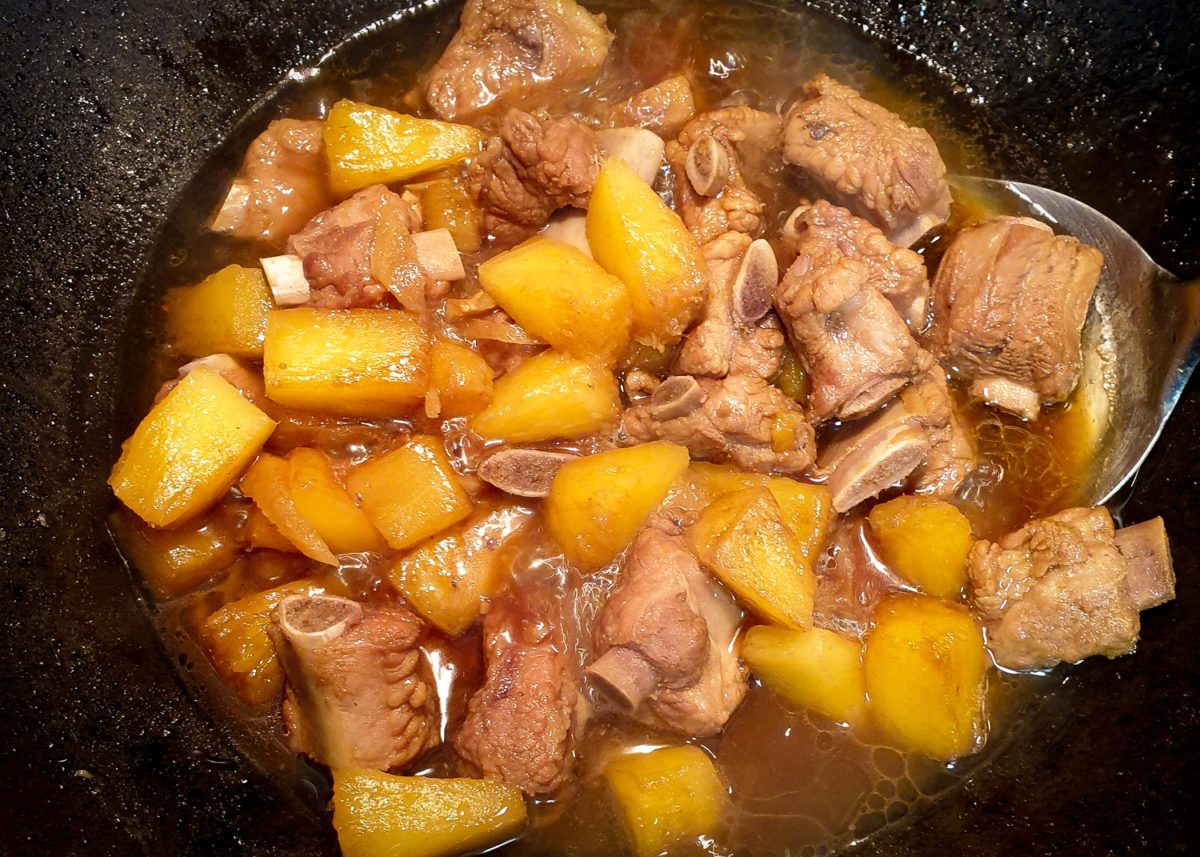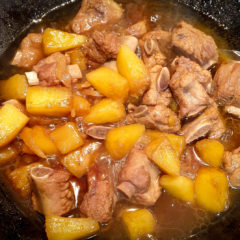GLUTEN-FREE / DAIRY-FREE

No deep-frying, no cooking oil, and no artificial coloring or flavoring, I love making these tender and scrumptious pork ribs with 100% natural ingredients and a fruity twist. With this stove-top recipe where the ribs are cooked in liquid, you won’t ever have to worry about them turn out being too dry. Just allow a little time, the ribs always come out tender and juicy.
Although this recipe involves a few more steps than most of my other recipes, each step is simple and fool-proof. Forget about the greasy takeaways covered in commercial sauces, make this favorite Chinese classic the way it deserves.
SWEET AND SOUR PORK RIBS WITH PINEAPPLE

GLUTEN-FREE / DAIRY-FREE
MAKE 4 servings PREPARATION 5 min COOK 40 min
Ingredients
- 1kg (2 lbs) pork ribs
- 1 cup of fresh pineapple pieces
- thumb-sized ginger, slice a few times
- 3 tbsp sugar
- 2 tbsp soy sauce
- 2 tbsp vinegar
- 1 tbsp spirit (optional, see Recipe Notes)
- a few star anises (optional)
Method
- Boil 1 kettle of water for use later. Cut up the ribs between the bones and wash in cold water. Change the water a few times until the water is clear. Drain and pat dry the ribs with a paper towel and set aside.
- To make the caramel, dissolve the sugar in 4 tablespoons of water in a wok, then bring the liquid to boil on high heat. When the liquid starts to bubble, turn the heat to medium. Stirring the liquid with a small spoon until the liquid reassembles the color and consistency of syrup.
- Add the ribs into the wok, turn the heat on high, stir constantly for 1 to 2 minutes until most of the ribs are coated with the caramel and turn golden. Add the ginger, soy sauce, spirits and star anises, stir fry for another minute.
- Add the boiled water to cover the ribs. Cover the wok and let the liquid boil on medium heat for 20 minutes. Stir occasionally.
- Mix in the pineapple pieces and continue to boil for another 10 minutes. Uncover the wok, mix in the vinegar, turn the heat on high, let boil until the liquid is reduced by about 2/3. Serve immediately with vegetables and rice.
Recipe Notes and Substitutes
- The pineapple pieces can be left out if it is not your thing. Just add extra tablespoon of vinegar instead.
- For the spirit, I often use a good quality whiskey when I don’t have a good Chinese spirit at hand. You can also use a good quality wine, beer or Sake; increase the amount to compensate for the lower alcohol content. I skip the Chinese cooking wines from Asian supermarkets because of their almost non-existent alcohol content (about 2%), and the simple rule that I wouldn’t put an alcoholic drink into my food if I wouldn’t put them into my mouth.
More notes: Caramel gives this dish its signature rich flavor and golden color, from scratch. When I first started making this dish, I followed the traditional way of making caramel in a small amount of hot oil. I didn’t have success every time, and I really didn’t like the smoke. After some research, I started to make caramel in water. Once I started doing that, success every time! Not only my pinch point for cooking this dish was gone, I also got a recipe that required no cooking oil. A rare instance for a main dish of any kind, do you agree?
So where did I get the idea of pineapples for spare ribs? I know that some home and restaurant cooks would add sweet and sour tasting fruit sauce (such as plum sauce) in addition to vinegar to achieve a more interesting flavor. But being the person I am and reluctant to buy another processed item comes in a bottle, I decided to use fresh pineapple pieces instead. As it turns out, not only I love the fruity flavor pineapple lends to this dish, I also absolutely love the extra color and texture of the pineapple pieces!
Leave a Reply